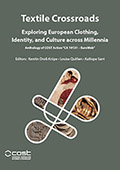Center, Textile Research

Textile Crossroads: Exploring European Clothing, Identity, and Culture across Millennia
Date of this Version
2024
Document Type
Article
Citation
In Textile Crossroads: Exploring European Clothing, Identity, and Culture across Millennia. Anthology of COST Action “CA 19131 – EuroWeb”. Kerstin Droß-Krüpe, Louise Quillien, & Kalliope Sarri, Editors. Zea Books, Lincoln, Nebraska, 2024. DOI: 10.32873/unl.dc.zea.1814
Abstract
While uneven in their scope and reach, studies of dress and dress complements (fibulae, belt buckles, buttons, etc.) have a significant tradition within the broader study of the pre- and protohistory of Mediterranean Europe. Many of these studies, however, have had a strong focus on the typology of the dress complements and ornaments themselves, either as chronological indicators, ethnic markers, or both. In more recent years, however, a shift in research agendas has ushered in the introduction of new perspectives and new ways of thinking about dress and bodily adornment.
This contribution explores one such perspective in particular — namely, the concept of bodily capital and its application to the interpretation of gendered regimes of dress — through selected case studies. Said case studies hail from two areas with strong traditions of research on dress and dress complements — the Iberian and the Italic Peninsulas (Figs. 1 & 2).
Regarding the former, examples from the Chalcolithic (see below, section 3.1.1) and the Late Bronze and Early Iron Ages of Southern Portugal (section 3.1.2) illustrate the evolution of regional regimes for the accumulation of bodily capital over time and show how these can highlight the gendered dynamics behind the sociopolitical development of communities in this area between the 3rd and the 1st millennia BC. For the latter, the examples of protohistoric Campania, with a focus on Pontecagnano and its surrounding area (section 3.2.1), and the Archaic Period in the Picenum, with a focus on the site of Numana (section 3.2.2), illustrate the role of dress, and especially female dress, in displays of bodily capital. These have far-reaching implications which go beyond the local and regional scale and must be set against the backdrop of the increasing connectivity of Mediterranean communities throughout the 1st millennium BC.
As will be seen, all these case studies offer insights and clues on how to approach dress and its relationship to both embodied identities and lived experiences of gender (but also status) from different and innovative angles. Before delving into them, however, it seems useful to start by briefly reviewing the development of theoretical and methodological approaches to dress in archaeological research, and to set out the conceptual framework of this study by briefly discussing the notion of bodily capital, its origin and potential applications for the topic at hand.
Included in
Ancient History, Greek and Roman through Late Antiquity Commons, Archaeological Anthropology Commons, Classical Archaeology and Art History Commons, Classical Literature and Philology Commons, Eastern European Studies Commons, European History Commons, European Languages and Societies Commons, Fiber, Textile, and Weaving Arts Commons, History of Science, Technology, and Medicine Commons, Human Geography Commons, Museum Studies Commons, Place and Environment Commons, Social and Cultural Anthropology Commons, Women's Studies Commons


Comments
Copyright © 2024 by the authors.